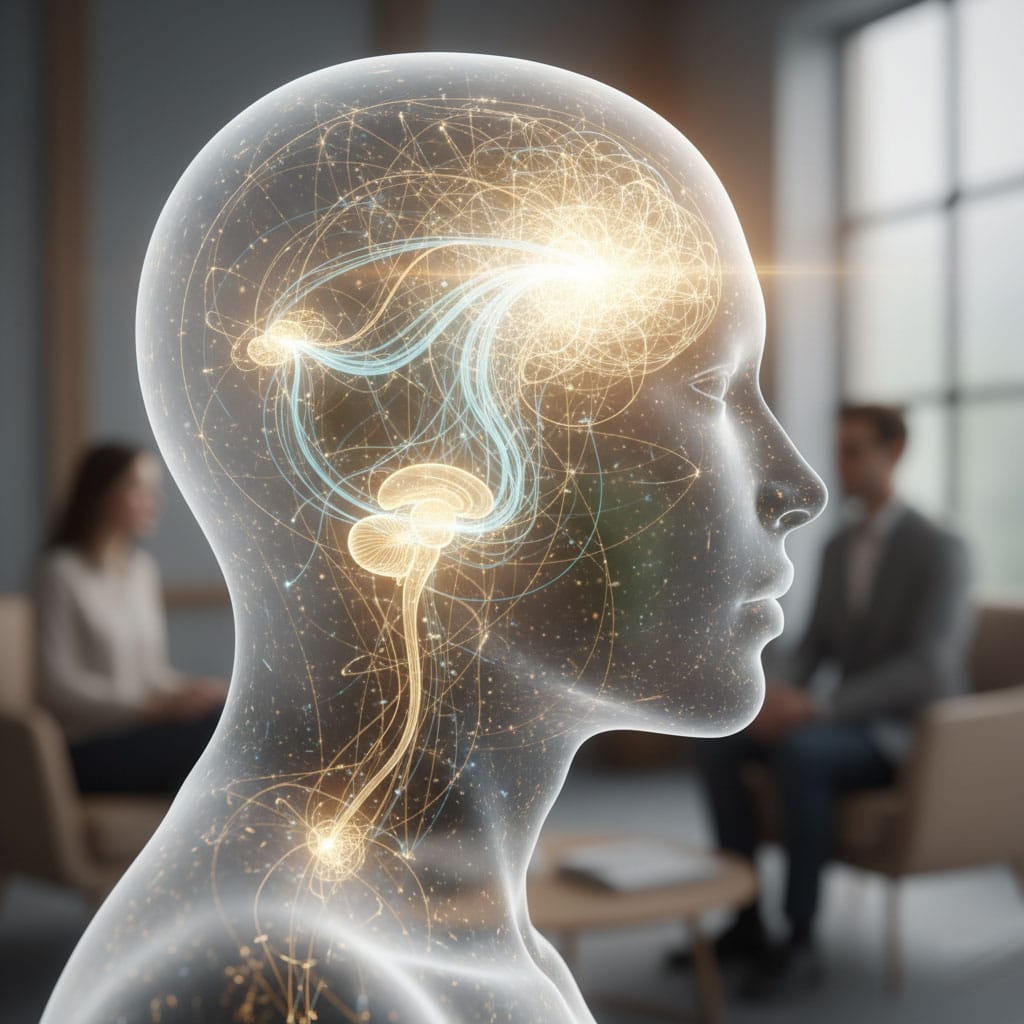
There’s a quiet moment after trauma when a client says, “I know it’s over, but it doesn’t feel over.”
They can list the facts — the event ended years ago, the threat is gone — yet their heart still races at night, their body still braces at certain sounds.
This gap between logic and feeling is where neuroscience offers profound clarity.
Trauma isn’t just psychological; it’s neurobiological. It changes how the brain encodes memory, how the body perceives safety, and how both communicate with each other.
For clinicians, understanding the neuroscience of trauma is more than academic curiosity — it’s the key to empathy and precision. When we grasp how trauma reshapes the brain, we stop asking, “Why can’t they just move on?” and start asking, “What’s happening in their neural circuitry that keeps them in defense?”
This article explores the science behind trauma, memory, and healing — not to reduce pain to biology, but to show that biology is often the most compassionate explanation of all.
How Trauma Affects the Brain
The Role of the Amygdala, Hippocampus, and Prefrontal Cortex
The brain’s trauma response is orchestrated by three primary regions:
- The Amygdala — the brain’s alarm system.
- The Hippocampus — the timekeeper and storyteller.
- The Prefrontal Cortex — the rational decision-maker.
Under threat, the amygdala activates instantly, sending messages that flood the body with stress hormones like cortisol and adrenaline. It doesn’t wait for permission; its job is survival.
When danger strikes, the prefrontal cortex — responsible for logic and impulse control — partially shuts down. That’s why trauma survivors often describe feeling frozen or acting “without thinking.” The brain isn’t malfunctioning; it’s prioritizing safety.
Meanwhile, the hippocampus, which normally organizes memories by time and context, goes offline under extreme stress. It can’t label the event as past. The fragments of experience — sound, smell, pain, panic — remain stored in sensory form, unintegrated.
This is why years later, survivors can feel as if the trauma is happening now. Their amygdala screams “danger,” the hippocampus can’t confirm “it’s over,” and the prefrontal cortex struggles to mediate between the two.
In trauma therapy, every grounding exercise, every breath, every mindful pause is an act of helping these regions talk to one another again.
Why the Brain Misinterprets Safety as Threat
One of the cruelest legacies of trauma is that safety can feel dangerous.
After trauma, the nervous system becomes sensitized — its alarm threshold lowers dramatically. The amygdala learns to associate even neutral cues with potential danger. A slammed door, a tone of voice, a smell — these benign triggers activate the same neural networks as the original threat.
This misinterpretation is known as generalization.
The brain, trying to protect, begins to overlearn fear. It says, “Anything that even slightly resembles danger might be danger.”
Meanwhile, the prefrontal cortex — the part that could rationally assess the situation — remains inhibited under stress. The result is a perpetual cycle: the body reacts first, and cognition tries to catch up later.
Clients often say, “I know I’m safe, but my body doesn’t believe me.” They’re right. Their nervous system needs evidence, not reassurance. Therapy provides that evidence through repeated, embodied experiences of safety — teaching the brain, through repetition, that calm can coexist with vulnerability.
Understanding the Polyvagal Theory: Tools for Regulating the Nervous System
The Biology of Flashbacks and Intrusive Thoughts
Flashbacks are not memory failures; they’re memory reactivations.
When trauma memories are stored without proper hippocampal tagging, they remain as sensory fragments — images, smells, bodily sensations. Later, when a trigger resembles the original stimulus, the amygdala fires and those fragments resurface, not as memories but as experiences.
The client isn’t “remembering” the event; they’re reliving it — physiologically and emotionally.
This explains why flashbacks can feel so real and why reasoning rarely helps in the moment. The brain’s survival network bypasses logic entirely.
Intrusive thoughts function similarly. The mind loops over distressing content because the memory hasn’t yet been properly filed. EMDR and other reprocessing techniques work precisely because they help the hippocampus complete this filing process.
Once the brain understands, this happened, and it’s over, the memory loses its power to ambush.
Memory Formation and Trauma
Implicit vs. Explicit Memory
Memory isn’t a single system — it’s a constellation of networks.
- Explicit (declarative) memory is conscious recall — facts and events you can describe in words.
- Implicit memory is unconscious — the body’s stored patterns, conditioned responses, and emotions.
Trauma primarily lodges in implicit memory. That’s why clients can forget details yet still feel terror when they smell a certain cologne or hear footsteps. Their implicit memory recognized danger long before explicit memory could name it.
Effective trauma therapy aims to bridge the two: to transform implicit sensations into explicit understanding. When a client says, “Oh — that panic I feel when someone shouts is my body remembering,” the memory begins to integrate. Awareness brings coherence where fragmentation once ruled.
Somatic Therapy Techniques Every Trauma Clinician Should Know
How Trauma Fragments Time and Narrative
Under ordinary stress, the hippocampus timestamps experiences — “This happened yesterday, in that place.”
But during trauma, the stress hormone cortisol disrupts this process. The memory becomes disorganized: pieces of image, sound, and emotion without chronology.
That’s why trauma memories often surface as disconnected sensations rather than coherent stories. Clients might say, “I don’t know what happened first,” or “It’s just flashes.”
Narrative collapse isn’t weakness; it’s neurobiology. The hippocampus did what it had to do — prioritize survival over storytelling.
When therapy helps clients piece these fragments into a timeline, the brain reclassifies the experience as past. The threat moves from “happening now” to “something that happened.” That single shift marks the moment healing begins.
How EMDR Works: Clinical Strategies for Trauma Reprocessing
The Role of Bilateral Stimulation in Memory Integration
EMDR and other trauma therapies use bilateral stimulation (BLS) — alternating eye movements, taps, or sounds — to reprocess traumatic memories. But why does it work?
Neuroscientifically, BLS engages both hemispheres of the brain, creating a bridge between emotional and rational processing. The mechanism resembles REM sleep, during which the brain naturally consolidates emotional experiences into long-term memory.
When clients recall traumatic memories while simultaneously engaging BLS, the memory is reactivated but within a context of safety. This dual attention — past and present coexisting — allows the hippocampus to reorganize the fragmented memory and file it correctly.
The result is not forgetting but transformation. The emotional charge dissipates; the memory becomes narrative rather than nightmare.
CPT vs EMDR: Choosing the Right Path for PTSD Treatment
Neuroplasticity and the Path to Recovery
How the Brain Learns to Regulate Again
For decades, neuroscience treated the adult brain as static. We now know it’s profoundly adaptable. Neuroplasticity — the brain’s ability to rewire itself — is the cornerstone of trauma recovery.
Each time a client successfully grounds during distress, they’re building new neural pathways that associate sensation with safety rather than threat. Each mindful breath strengthens inhibitory circuits between the prefrontal cortex and amygdala.
Therapy literally becomes brain training — not metaphorically, but biologically.
Consistent regulation practices shift default neural firing patterns. Over time, the amygdala quiets, the hippocampus grows in volume, and the prefrontal cortex reclaims authority. Studies show measurable brain changes after effective trauma treatment — evidence that healing isn’t just emotional; it’s anatomical.
Integrating Mindfulness into Trauma Therapy Sessions
Repetition and Experience in Neural Rewiring
Neural change requires repetition plus emotion.
Information alone doesn’t rewire the brain; experience does.
That’s why repeated exposure to safe, embodied experiences matters more than intellectual insight. Each time a client practices grounding after a trigger, the new pathway strengthens — “I can feel fear and stay here.”
The phrase neurons that fire together wire together captures this perfectly. Every regulated breath, every somatic release, every compassionate reflection reinforces safety circuits.
In therapy, we’re not erasing the trauma; we’re teaching the brain to tell a different story about it.
Somatic Therapy Techniques Every Trauma Clinician Should Know
The Hope of a Resilient Nervous System
Even after years of trauma, the nervous system remains capable of repair. Resilience isn’t the absence of stress; it’s the regained flexibility to move between activation and calm.
Think of the nervous system like a muscle — disused and stiff after years of contraction, but capable of softening with practice.
Through safe relational experiences, mindfulness, and somatic engagement, flexibility returns.
This truth is the heart of trauma therapy: the body remembers, but it can also relearn.
Clinical Events’ Brain-Based Healing CE workshops dive deep into these neuroplastic principles, showing therapists how to translate neuroscience into real clinical change.
Trauma Events for Clinicians
Using Neuroscience to Empower Clients
Psychoeducation as a Therapeutic Tool
For many clients, learning the science behind their symptoms is profoundly validating.
Explaining trauma through neuroscience reduces shame. When clients hear, “Your amygdala is doing its job too well,” they stop viewing panic as personal failure and start seeing it as physiology.
Psychoeducation demystifies the body’s reactions and invites self-compassion. Clinicians can use visual diagrams or metaphors — “Your brain’s smoke alarm is just too sensitive right now” — to normalize what once felt incomprehensible.
Empowered understanding turns therapy from symptom management into collaborative healing.
Explaining the Science of Safety
Clients often believe they need to think their way out of trauma. But safety is felt, not reasoned.
Explaining this helps clients stop blaming themselves for not “getting better faster.” Therapists can say, “Your body needs to learn safety the same way it learned danger — through repeated experience.”
By reframing recovery as reconditioning rather than willpower, clients relax into the process. They begin to notice subtle progress — longer moments of calm, deeper sleep, or easier connection. These are not small; they’re signs of rewired neural pathways.
Understanding the Polyvagal Theory: Tools for Regulating the Nervous System
Building Client Confidence Through Knowledge
Knowledge itself is regulating. When clients understand what’s happening inside them, fear decreases and agency increases.
Encouraging clients to track their own nervous system patterns — what activates them, what soothes them — builds interoceptive awareness and autonomy.
Over time, clients shift from Why am I like this? to I know what my body needs.
That empowerment is not just educational; it’s neurobiological self-leadership.
Trauma Therapy for Clinicians: Evidence-Based Paths to Healing and Recovery
CE Opportunities in Neurobiology
Clinical Events CE Courses on Brain-Based Healing
Clinical Events offers CE-accredited trainings that translate neuroscience into actionable clinical tools.
Participants explore:
- The brain’s trauma circuitry and recovery mechanisms.
- Neuroplastic techniques for regulation and memory integration.
- Applied use of mindfulness, EMDR, and somatic interventions.
- Live case demonstrations of brain-informed trauma work.
These workshops combine lecture with embodied practice — ensuring clinicians don’t just learn about neuroscience but learn how to use it to heal.
Applying Neuroscience Research to Clinical Practice
The future of trauma therapy is integrative — where neurobiology, somatic awareness, and evidence-based interventions converge.
Clinical Events’ advanced trainings help therapists:
- Interpret neuroimaging findings into client-friendly language.
- Incorporate polyvagal and neuroplasticity principles into everyday sessions.
- Use psychoeducation to enhance therapeutic alliance and reduce dropout rates.
When clinicians understand the brain, they no longer guess what’s happening — they guide it.
Top Trauma CE Trainings and Certifications for Therapists in 2025
FAQs
How does trauma physically change the brain?
Trauma alters the structure and function of the amygdala, hippocampus, and prefrontal cortex. The amygdala becomes overactive, the hippocampus shrinks and loses temporal accuracy, and the prefrontal cortex weakens its regulatory control. These changes create hypervigilance, fragmented memory, and emotional dysregulation — all reversible through therapy.
Can trauma permanently damage memory?
While trauma can temporarily impair memory consolidation, it rarely causes permanent loss. With treatment — especially EMDR, somatic, or mindfulness-based approaches — the hippocampus regains function and memories integrate coherently. The brain remains plastic throughout life.
What are the most effective brain-based trauma therapies?
EMDR, Somatic Experiencing, and Mindfulness-Based Trauma Therapy have the strongest neurobiological evidence. They target different neural circuits but share a goal: calming the amygdala, strengthening the prefrontal cortex, and integrating fragmented memory networks into cohesive narratives.

